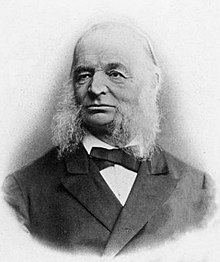Otto Wilhelm von Struve

Otto Wilhelm von Struve (May 7, 1819 (
Early years
Struve was born in 1819 in
Scientific work

During 1843 and 1844, Struve participated in longitude measurements between Altona, Greenwich and Pulkovo, which were based on large displacement of chronometers over the Earth surface. This newly developed method was adopted in Russia, and from 1844, the longitude was measured starting not from the Tartu Observatory but from the Pulkovo Observatory. Much of the 1844 Struve dedicated to studying the Sun. He deduced its apex coordinates and linear velocity as 7.3 km/s. Although it was significantly smaller than the correct value of 19.5 km/s measured in 1901, Struve's result was correct in that the velocity of the Sun was smaller than that of stars.[1][2][6][7]
In 1865 he discovered NGC 8, a double star in the constellation Pegasus. This occurred only 2 days after he discovered the spiral galaxy NGC 9 in the constellation Andromeda. Struve explored the constellation of Cassiopeia, finding double stars. He labeled them with his initials in the Greek alphabet, OΣ in his first catalogue[8] and OΣΣ in his appendix.[9]
Struve continued his father's work in several directions. In particular, they compiled famous Pulkovo
In 1851, while observing a solar eclipse, he concluded that the
Administration

Around 1845, von Struve's father withdrew from most management activities at the Pulkovo Observatory and focused on individual research. From then on, most of administrative duties fell on von Struve, especially in 1858 when his father was gravely ill. With his father's retirement in 1862, Otto officially became director and kept that position for 27 years until 1889. In the mid-1860s, the son's health deteriorated as well, to the point that neither he nor his physician hoped for recovery. However, instead of retiring, von Struve spent a full winter on leave in Italy and managed to restore his health.[4][12]
Struve remained a top authority at the Russian Academy and his requests, e.g. regarding staff appointments were always granted. The first refusal, in 1887, disappointed Struve so much that he applied for resignation and was stopped from that only by the Tsar Alexander III, who requested Struve to keep his posts until the 50th anniversary of the Pulkovo Observatory in 1889.[4]
For most of those years, the working language of the Pulkovo Observatory was German, as the staff members were largely foreigners. Struve had only limited command of Russian, yet he used it whenever possible.[4]
Visit to the United States
Otto was the first scientist of the Struve family to visit United States (in 1879: New York, Chicago and San Francisco). The visit served several purposes, including ordering the Alvan Clark & Sons optics for the new 30-inch telescope in Pulkovo,[13] and it was a part of long-term Russia-US astronomy partnership during the 19th century. Within that collaboration, many American astronomers stayed at Pulkovo for observations and exchanged data with Russian scientists by mail. By the initiative of Struve, two US astronomers, Simon Newcomb and Asaph Hall were appointed as Foreign Members of the Russian Academy of Sciences.[2]
Personal life and late years

Struve was married twice. His first wife was a daughter of German emigrants Emilie Dyrssen (1823–1868). They had four sons and two daughters who reached mature age. A few years after her death, Struve married Emma Jankowsky (1839–1902) and had another daughter with her. Two of his younger sons,
Awards and honors
Struve won the
See also
References
- ^ a b Otto Vasilevich Struve (in Russian)
- ^ a b c Отто Васильевич Струве Archived 2011-07-26 at the Wayback Machine (in Russian)
- Bibcode:1906PA.....14..352N.
- ^ doi:10.1086/121632.
- ISBN 978-90-277-2652-0.
- ^ a b Astronomy dates and discoveries, chapter 9 (in Russian). astro.websib.ru. Archived from the original on 2007-11-13.
- ^ doi:10.1038/072061a0.
- ^ A Cassiopeian Quartet: OΣΣ 254, OΣ 512, OΣ 511, Bu 1153
- ^ A Cassiopeian Quartet: OΣΣ 248, OΣΣ 251, OΣ 498, and ARY 33
- S2CID 122065816.
- ^ V. K. Abalkin et al. Struve dynasty Archived 2011-05-14 at the Wayback Machine (in Russian), St. Petersburg University
- ^ Newcomb, Simon (1880). "Sketch of Professor Otto Wilhelm Struve". The Popular Science Monthly. 17 (June): 263–264.
- ISBN 0-226-63946-0.
- doi:10.1038/154206a0.
- ^ "O.W. von Struve (1819 - 1905)". Royal Netherlands Academy of Arts and Sciences. Retrieved 20 July 2015.
- ISBN 3-540-00238-3.
- ^ Struve Geodetic Arc, UNESCO
Further reading
- Nyren, M. (1906). "Otto Wilhelm Struve". Popular Astronomy. 14: 352–368. Bibcode:1906PA.....14..352N.
| |||||||||||||||||||||||||||||||||||||||||||||||||||||||||||||||||||||||||||||||||||||||||||||||||||||||||||||||||||||||||||||||||||||||||||||||||||||||||||||||||||||||||||||||||||||||||||||||||||||||||||||||||||||||||||||||||||||||||||||||||||||||||||||||||||||||||||||||||||||||||||||||||||||||||||||||||||||||||||||||||||||||||||||||||||||||||||||||||||||||||||||||||||||||||||||||||||||||||||||||||||||||||||||||||||||||||||||||||||||||||||||||||||||||||||||||||||||||||||||||||||||||||||||||||||||||||||||||||||||||||||||
| Notes:
| |||||||||||||||||||||||||||||||||||||||||||||||||||||||||||||||||||||||||||||||||||||||||||||||||||||||||||||||||||||||||||||||||||||||||||||||||||||||||||||||||||||||||||||||||||||||||||||||||||||||||||||||||||||||||||||||||||||||||||||||||||||||||||||||||||||||||||||||||||||||||||||||||||||||||||||||||||||||||||||||||||||||||||||||||||||||||||||||||||||||||||||||||||||||||||||||||||||||||||||||||||||||||||||||||||||||||||||||||||||||||||||||||||||||||||||||||||||||||||||||||||||||||||||||||||||||||||||||||||||||||||||
